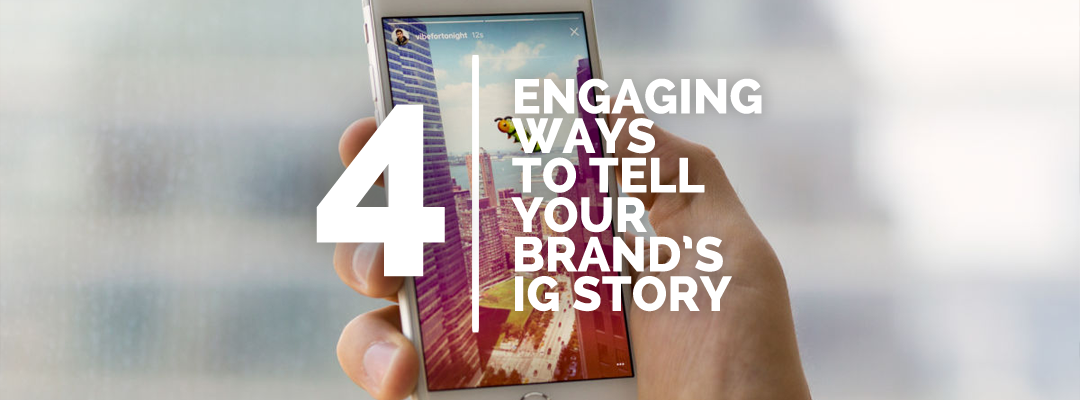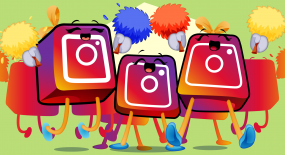4 Engaging Ways to tell your Brand’s IG Story

Everyday I am mastering the art of “storytelling”. It’s part of my business and everyday life. I believe it’s an important skillset for everybody, considering that you are selling yourself everyday whether you realize it or not. For instance, if you’re trying to get hired for a job, then your mission is to convince the decision maker that you are the right candidate. How do you do that? Simple, you must persuade the hiring manager that you are the right candidate by convincing them with your story. Similarly, when you go on your first date, you are indirectly telling a story about yourself in addition to hearing the other individual’s story.
Instagram has now provided us with another way to tell a story around a brand or individual. Instagram Stories came out August 2016 but it’s the newest kid on the block when it comes to brand creativity & advertising. I’ve been using it on my own Social pages, as well as for my clients. It’s a GREAT tool for engaging with existing fans and followers.
Since its launch, Instagram has been trying to introduce features for IG Stories little by little, and just this past month, Instagram has launched the ability for Full Page skippable Ads. They will be testing this new feature in IG Stories with more than 30 companies globally, such as L’Oreal, Buzzfeed, Nike, Capital One, General Motors, Coca Cola, and Netflix just to name a few.
In the coming weeks, Instagram plans to extend this ability to all advertisers. Instagram is also launching new tools to help businesses track the performance of their stories. Businesses with a “business profile” can see the reach, impressions, replies, and exits for each individual story within the Business Tools tab.

According to Forbes, Instagram said the metrics should help brands make content that is more relevant to their audience. With 150 million daily users, up from 100 million daily users three months ago – monetization of the tool will become increasingly important for Facebook. Instagram’s advertising business could generate about $3.64 billion in advertising sales this year, according to forecasts.
We’ve all tried to familiarize ourselves plenty with IG Stories’ functionality by now. There are a lot of ways you can use this tool. I find that it’s easier to use and understand for Brands and Marketers than what Snapchat has. Since its launch, people, as well as brands, have found many creative ways to use this perishable 24 hour content sharing tool.
The main idea for Instagram Stories is in its namesake. You, the user, tell your audience a story within a day until it gets deleted after 24 hours. This rule (similar to that of Snapchat) has given birth to many creative techniques because you’re only given a window of time to send something out.
Though, it shouldn’t be something that should be harrowing for a business owner like you. IG Stories should, for the most part, be candid and natural and often times should be unstaged. A ‘spur of the moment’ tool if you will. You could post at least 20 stories in a span of a day. So, let’s say for example, if you post a series of events within a day, that in itself would be enough to create great content for your Stories.
Still, it’s good to have a format to follow on what KIND of content you bring out when you decide to post on Stories.
Let’s take a look at the examples below and see why they’re highly effective ways to use this tool.
1. Buzzfeed’s 11 Ways to get rid of Hiccups
I know, the content is humorous and nonsensical (just like most of Buzzfeed’s churned out content), but the main thing we see here is that they’ve used IG Stories and convinced us to sit and watch through every slide because you want to know how it concludes. WILL he get rid of his hiccups this time? What will he be instructed to eat next? What they tried to do here is build your anticipation and suspense, going from the first thing to the next, building up to the most ridiculous thing, only to arrive at the most mundane answer. It feels like you’ve lost 5 minutes of your life watching it, but you’re engaged because you wanted to know how it ends. Just like how you would sit through a story.
Think of it as something like a comic book where you read through panels as you progress through the narrative.
2. Ouai Dry Shampoo Foam
This one’s pretty simple and straightforward. Basically listing off the ingredients one by one as each slide progresses. Remember how I said it should pan out like a comic strip? This is similar to that. Or to make a more accurate comparison, IG stories could be treated like a PowerPoint presentation where in you present each main topic through individual slides. Which in this case, are the list of natural ingredients for Ouai’s Dry Shampoo Foam.
3. Justin Bieber’s Plug for TMobile ( Super Bowl AD)
It’s a no brainer that a celebrity like Justin Bieber could rake in a hefty number of followers, not just on twitter, but also on his instagram. What he’s done here however is an example of Influencer Marketing that’s sponsored by TMobile for the Superbowl. There are two things to take note of:
a) This is one way you can leverage Influencer Marketing. Know which personalities or celebrities your brand could reach out to and let them get the word out to their already existing pool of fans. If your page doesn’t carry a good follower count you could always seek the help of endorsers or influencers. Building a relationship with an endorser through stories is a great way to leverage engagement.
b) The #unlimitedmoves campaign aligned with TMobile’s feature of Unlimited Data. At the end of his Story, Beiber used a call to action (CTA) and encouraged his followers to “show him their touchdown moves,” by using the hashtag #unlimitedmoves which had soon gone viral in the wake of the Super Bowl. Which goes to show that using something that’s hot, trending and relevant could garner you an increase of followers and engagement.
So to recap, let’s try to break all of this down. An effective IG Story should:
- Tell a story
- Keep your audience in anticipation and suspense.
- Keep your audience engaged and wanting to learn more by the end.
- Have them relate to your content and participate


